Barry Taylor
Why Blue?
Interesting article by Derek. I’m sure there’s a lot of truth in this because there’s no doubt that, in the 1920s and 30s, City were the real powerhouse in Manchester. I was born in 1944 and, though Blue from birth somehow, it was really the 1950s before I began to understand football. My father was a football fanatic but not by birth a City or United supporter because he came from Wrexham and, in those days, you supported your local team. He came to live in Manchester in the late 1920s and, being football mad, he asked his workmates who they were going watch, City or United. As he recalled, they looked dumbstruck: ‘The Rags, who the hell would want to watch such a load of rubbish!’ So, he started to watch City and I don’t think that he went to Old Trafford until the 40s or 50s, when the practice was to go one week to Maine Road and the next to Old Trafford with his workmates, simply to watch a first division match (don’t forget, there was no travelling to away matches in those days).
My first match was City vs. Bolton at Maine Road, around Christmas/New Year 1954 – think City won 2-0. From then on, that season, I went to a few matches with him and his workmates, mainly at Maine Road but also one or two at Old Trafford. Apart from the natural antipathy to anything red, Old Trafford was much more difficult to get to from our home in Benchill and always seemed very poky and crowded when compared to the spaciousness of Maine Road. Just to give some idea of the attitude of crowds in those days, I recall standing with my father on what became the Stretford End (I seem to recall that there was a little enclosed ‘paddock’ at the front). The game must have been pretty boring because when they opened the gates 15-20 minutes from the end, a lot of the crowd streamed out to watch the lads from Glover’s Cables playing on the pitch that was just behind the Stretford End!
For those interested in football history, my grandfather was secretary of the Football Association of Wales in the 1880s and early 1890s and had been connected with Wrexham. He was one of pioneers who brought soccer to the rugby stronghold of South Wales, helping to launch clubs such as Cardiff. It is possible that helped to introduce other innovations, such as permanent crossbars (instead of a piece of string!), the three half-back formation and, even, the offside rule. Thanks to Ian Garland and his fellow researchers in Welsh soccer, I have been able to build up a good picture of his ‘exploits’, which shed an interesting light on the development of football in the 19th century. If there is anyone out there interested, I’d be happy to correspond and would welcome any further input.
Meanwhile, as an exile in the west of Ireland, thanks to Phil and the gang for their sterling efforts and to Phil B. for his masterly reporting of our games.
Related Posts
-
 Keith Bloomer
No Comments | Dec 23, 1999
Keith Bloomer
No Comments | Dec 23, 1999 -
 Vancouver Blue
No Comments | Oct 27, 1997
Vancouver Blue
No Comments | Oct 27, 1997 -
 Jon Poole
No Comments | Mar 3, 1997
Jon Poole
No Comments | Mar 3, 1997 -
 Allan Wilson
No Comments | Nov 15, 1999
Allan Wilson
No Comments | Nov 15, 1999
